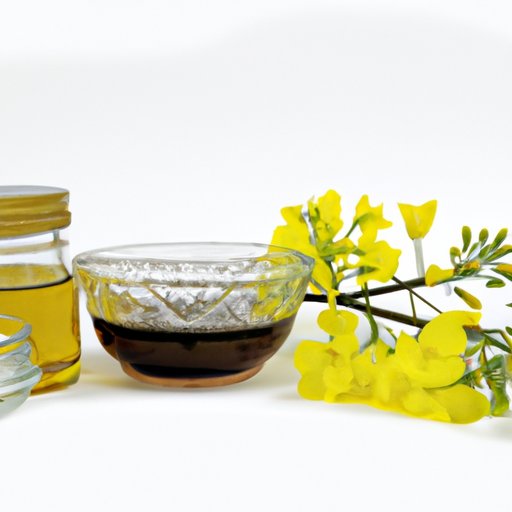I. Introduction
When you think of cooking oils, canola oil is probably one of the first that comes to mind. Canola is a versatile crop that has become a staple in kitchens around the world. In this article, we will explore what canola is, its benefits, and its sustainability.
II. What is Canola? A Beginner’s Guide to Understanding This Versatile Plant
Canola is a type of rapeseed that was specifically bred to be low in erucic acid and glucosinolates, which can be harmful to animal and human health. In the 1970s, it was officially accepted as a crop in Canada, and now it is grown all over the world.
Canola can be distinguished from other types of rapeseed by its bright yellow flowers, small black seeds, and thin seed coats. It is a member of the Brassicaceae family, which includes other cruciferous vegetables like broccoli, kale, and cauliflower.
Canola plants are usually short-lived, and they can grow up to six feet tall. The leaves are green and the stems are typically a grayish-brown color. The flowers, which bloom in late spring or early summer, attract pollinators such as bees and butterflies.
Canola is typically grown in cool climates with moderate rainfall. The main countries producing canola are Canada, China, and Australia.
III. The Health Benefits of Canola Oil: Understanding the Nutritional Value and Cooking Uses
Canola oil is one of the healthiest cooking oils available. It is high in monounsaturated fat and low in saturated fat, making it a heart-healthy option. In fact, the U.S. Food and Drug Administration (FDA) has approved a health claim for canola oil stating that “eating about 1 1/2 tablespoons of canola oil daily may reduce the risk of coronary heart disease due to the unsaturated fat content in canola oil.”
Canola oil is also a good source of omega-3 fatty acids, which have anti-inflammatory properties and may help prevent chronic diseases such as cancer and arthritis. Vitamin E, an antioxidant that protects against cell damage, is also present in canola oil.
Canola oil has a high smoke point, which means it can withstand high temperatures without breaking down and producing harmful compounds. This makes it ideal for frying, baking, and sautéing.
IV. From Farm to Table: How Canola is Grown, Harvested, and Processed into Various Products
Canola is typically planted in the spring and harvested in the fall. The harvesting process involves cutting the canola plants and threshing them to separate the seeds from the rest of the plant material. The seeds are then cleaned and dried before being processed into various products.
The most common product derived from canola is oil, which is produced through a process of solvent extraction. The remaining material, called canola meal, is used as a protein source in animal feed. Canola meal is also used in the production of biodiesel, which is a renewable fuel source made from plant oils.
Canola oil is used in a variety of industries, including food, cosmetics, and lubricants.
V. Canola vs. Rapeseed: Understanding the Differences Between These Two Plants
While canola and rapeseed are both members of the Brassicaceae family, there are some key differences between the two plants. Rapeseed contains high levels of erucic acid, which can be toxic in large amounts. Canola, on the other hand, was bred to be low in erucic acid and is considered safe for consumption.
Rapeseed oil is often used for industrial purposes, such as in the production of lubricants and biofuels. It is also used in some cuisines, but it is less commonly used than canola oil.
VI. The Science behind Canola: Exploring the Genetic Modification and Engineering of This Crop
Like many crops, canola has been genetically modified to improve its yield and resistance to pests and diseases. The genetic modification involves inserting genes from other organisms into the canola genome to produce specific traits.
While genetic modification has been controversial, proponents argue that it can help increase food production and reduce dependence on pesticides and other harmful chemicals. However, some critics are concerned about the potential long-term effects of genetically modified organisms on human health and the environment.
VII. Sustainability and Canola: How This Crop is Helping to Protect the Environment and Support Farmers
Canola is a sustainable crop that can have many environmental benefits. For example, canola plants have a deep root system that can help prevent soil erosion and improve soil health. Canola also requires less water and fertilizer than other crops, making it a more sustainable option for farmers.
Canola oil and meal products are also environmentally friendly. Canola oil is biodegradable and produces less greenhouse gas emissions than other types of cooking oils. Canola meal can be used as a natural fertilizer, reducing the need for chemical fertilizers.
In addition, canola production can help support local economies by providing jobs and income for farmers and rural communities.
VIII. Conclusion
Canola is a versatile and sustainable crop that has many benefits for both human health and the environment. From its nutritional value as a cooking oil to its potential to reduce greenhouse gas emissions, canola is an important crop for the future. By understanding the science behind canola and its potential for sustainability, we can make informed choices about how we grow, harvest, and consume this valuable crop.
